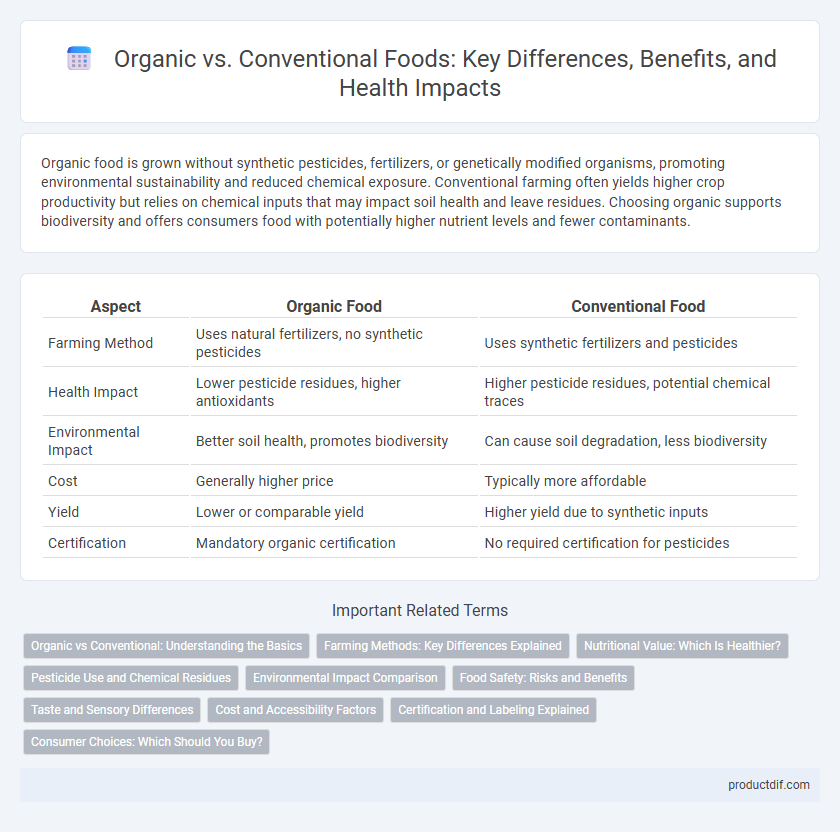Organic food is grown without synthetic pesticides, fertilizers, or genetically modified organisms, promoting environmental sustainability and reduced chemical exposure. Conventional farming often yields higher crop productivity but relies on chemical inputs that may impact soil health and leave residues. Choosing organic supports biodiversity and offers consumers food with potentially higher nutrient levels and fewer contaminants.
Table of Comparison
| Aspect | Organic Food | Conventional Food |
|---|---|---|
| Farming Method | Uses natural fertilizers, no synthetic pesticides | Uses synthetic fertilizers and pesticides |
| Health Impact | Lower pesticide residues, higher antioxidants | Higher pesticide residues, potential chemical traces |
| Environmental Impact | Better soil health, promotes biodiversity | Can cause soil degradation, less biodiversity |
| Cost | Generally higher price | Typically more affordable |
| Yield | Lower or comparable yield | Higher yield due to synthetic inputs |
| Certification | Mandatory organic certification | No required certification for pesticides |
Organic vs Conventional: Understanding the Basics
Organic food is cultivated without synthetic pesticides, herbicides, or genetically modified organisms, prioritizing natural growth processes and soil health. Conventional farming relies on chemical inputs and genetically engineered seeds to enhance yield and pest resistance, often at the expense of soil biodiversity. Consumers choose organic for perceived health benefits and environmental sustainability, while conventional offers affordability and higher production efficiency.
Farming Methods: Key Differences Explained
Organic farming relies on natural fertilizers like compost and manure, avoids synthetic pesticides, and emphasizes crop rotation to maintain soil health. Conventional farming commonly uses chemical fertilizers and pesticides to maximize yield and controls pests through synthetic means. These differing methods impact soil sustainability, biodiversity, and potential chemical residues in food products.
Nutritional Value: Which Is Healthier?
Organic foods often contain higher levels of certain nutrients, such as antioxidants, vitamin C, and omega-3 fatty acids, compared to their conventional counterparts. Studies indicate that organic produce tends to have lower pesticide residues and may offer better nutrient density due to soil health and farming practices. However, the overall nutritional differences between organic and conventional foods are modest, and both can be part of a healthy diet.
Pesticide Use and Chemical Residues
Organic foods are cultivated without synthetic pesticides, significantly reducing chemical residues compared to conventional crops that often rely on multiple pesticide applications. Studies indicate organic produce contains lower levels of pesticide residues, minimizing potential health risks associated with chemical exposure. Choosing organic supports reduced environmental contamination and promotes safer consumption by limiting synthetic chemical intake.
Environmental Impact Comparison
Organic farming reduces chemical pesticide and synthetic fertilizer use, leading to lower soil and water contamination compared to conventional methods. It promotes biodiversity and enhances soil health through crop rotations and natural pest control, contributing to greater ecosystem resilience. Conventional agriculture often results in higher greenhouse gas emissions and nutrient runoff, exacerbating environmental degradation and climate change effects.
Food Safety: Risks and Benefits
Organic food reduces exposure to synthetic pesticides and antibiotics, lowering the risk of chemical residues and antibiotic-resistant bacteria. Conventional food may carry higher levels of pesticide residues and potential contaminants but often undergoes rigorous safety testing to meet regulatory standards. Both organic and conventional foods must comply with food safety regulations, yet organic products generally offer benefits in minimizing chemical risks.
Taste and Sensory Differences
Organic foods often exhibit more complex and distinct flavor profiles due to natural growing methods that enhance nutrient density and soil quality. Conventional produce may have a milder taste influenced by synthetic fertilizers and pesticides, which can impact texture and aroma. Sensory evaluations consistently reveal that organic fruits and vegetables tend to deliver richer aromas, firmer textures, and more vibrant colors, contributing to an overall superior eating experience.
Cost and Accessibility Factors
Organic food typically costs 20-60% more than conventional alternatives due to higher production expenses and certification fees. Accessibility remains limited as organic products are often found in specialty stores or higher-end supermarkets, contrasting with the widespread availability of conventional foods in most grocery outlets. Consumer preference for organic options can be constrained by budget and location, impacting overall market demand.
Certification and Labeling Explained
Organic foods are certified through rigorous standards set by organizations such as the USDA Organic, ensuring no synthetic pesticides or fertilizers are used. Conventional foods lack this certification and may contain residues from chemical inputs commonly allowed in standard farming practices. Labeling on organic products clearly indicates compliance with these standards, providing consumers assurance of natural production methods.
Consumer Choices: Which Should You Buy?
Consumers choosing between organic and conventional food should consider factors like pesticide exposure, environmental impact, and nutritional value. Organic foods typically contain fewer pesticide residues and are grown using sustainable practices, appealing to health-conscious buyers and eco-friendly consumers. Conventional foods often cost less and provide a wider variety, making them practical for budget-conscious shoppers.
Organic vs Conventional Infographic

 productdif.com
productdif.com